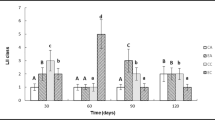Abstract
Using a combination of a primary growth retardant, mefluidide, a synergistic additive, chlorsulfuron, a detergent to enhance penetration (X-77), and a herbicide, 2,4-D, to provide for control of broadleaf weeds, full-season management of bluegrass (Poa pratensis L.)—tall fescue (Festuca arundinaceae Schreb.) mixtures along roadsides has been achieved. A single spray application is made in the spring, and no additional herbicide applications or mechanical mowing are needed. The treatment is effective with greater than 90% control of fescue seed heads. Those few seed heads that do form remain short. It is economical. The costs of materials and application are equal to or less than the cost of a single mowing cycle. The treatment is environmentally safe when applied in early spring before most agricultural crops have been planted. The effectiveness and low cost of the combination derive from laboratory and greenhouse observations that various materials, herein referred to as additives, often only weakly effective as growth retardants themselves, will interact synergistically with mefluidide to provide overall treatment effectiveness at application rates that are economical. Using this principle, a combination suitable for roadside vegetation management was devised, field-tested for 2 years under actual use conditions, and found to be effective for full-season vegetation management of mixed bluegrass—tall fescue turf to permit considerable cost savings when compared to three-cycle mechanical mowing.
Similar content being viewed by others
References
Bloomberg JR, Wax LM (1978) Absorption and translocation of mefluidide by soybeans (Glycine max), common cocklebur (Xanthium pennsylvanicum) and giant foxtail (Sertaria faberi). Weed Sci 26:434–440
Colby SR (1967) Calculating synergistic and antagonistic responses of herbicide combinations. Weeds 15:20–22
Glenn SD, Glenn B, Rieck CE, Ely DG, Bush LP (1981) Chemical quality,in vitro cellulose digestion, and yield of tall fescue forage affected by mefluidide. J Agric Food Chem 29:1158–1161
Jagshitz JA (1982) Evaluation of growth retardants in cool season lawn turf. Northeast Weed Sci Soc Proc 36:334–335
McWhorter CG, Barrentine WL (1979) Weed control in soybeans (Glycine max) with mefluidide applied postemergence. Weed Sci 27:42–47
Rao SR, Harger TR (1981) Mefluidide bentazon interactions on soybeans (Glycine max) and red rice (Oryza sativa). Weed Sci 29:208–212
Tautvydas KJ (1983) Synergistic growth retardation of grasses with mefluidide/PGR combinations. Proc PGRSA 10:51–56
Watschke TL, Wehner DJ, Duich JM (1977) Initial and residual effects of growth regulators on a Pennstar-Flyking Kentucky bluegrass blend. Proc Northeast Weed Soc 31:378–389
Wilkinson RE (1982) Mefluidide inhibition of sorghum growth and gibberellin precursor biosynthesis. J Plant Growth Regul 1:85–94
Author information
Authors and Affiliations
Rights and permissions
About this article
Cite this article
Morré, D.J., Tautvydas, K.J. Mefluidide-chlorsulfuron-2,4-D surfactant combinations for roadside vegetation management. J Plant Growth Regul 4, 189–201 (1985). https://doi.org/10.1007/BF02266957
Received:
Accepted:
Issue Date:
DOI: https://doi.org/10.1007/BF02266957




